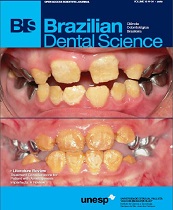Surface roughness of indirect composites using different polishing systems
DOI:
https://doi.org/10.14295/bds.2013.v16i4.927Resumo
Objective: The aim of this study was to evaluatethe surface roughness of indirect composites afterpolishing with aluminum oxide (Al2O3) discs. Materialand Methods: One-hundred and eighty specimenswere confectioned with 6 indirect composites using aprefabricated matrix, resulting in six groups (n-30):Group SO - Solidex, Group SI - Signum, Group SF- Sinfony, Group OP - Opallis; Group RE - Resilab,Group EP - Epricord, Group AD - Adoro. Each groupwas divided into three subgroups according to thepolishing (n-10): Subgroup C (Control) - withoutpolishing (polyester strip); Subgroup S - polishingwith Sof-Lex discs; Subgroup T - polishing with TDVdiscs. The surface roughness was measured with aprofilometer. Results: The results were analyzed byANOVA and Tukey tests (5%), resulting in p = 0.00.The mean values (±standard-deviation) measured inRa (?m) for each Group/Subgroup were: RE/C - 0.14(± 0.14) a; EP/C - 0.18 (± 0.46) ab; SO/C - 0.24 (±0.22) abc; SF/S - 0.24 (± 0.17) abc; SF/C - 0.26 (±2.54)abc; SI/C - 0.30 (± 0.34)abcd; SO/T - 0.33(±0.42) abcd; AD/S - 0.34(± 0.88)abcd; AD/C - 0.37(±0.60)ab; SI/S - 0.37(± 1.39)bcd; SO/S - 0.43(± 0.26)cd; EP/S – 0.44 (± 1.02) cd; RE/S - 0.54(±2.02) de;SI/T - 0.65(± 0.88)ef; RE/T - 0.83 (± 0.54) fg; SF/T- 0.85 (± 0.21) fg; AD/T - 0.88 (± 1.74) fg; EP/T- 0.91(± 0.89) g. Conclusion: It is concluded thatpolyester strip resulted in significantly lowest surfaceroughness; polishing with TDV discs resulted insignificantly higher surface roughness compared toSof-Lex discs and that the surface roughness resultsdepend on the composite tested.
Keywords
Composite resins; Dental polishing; Biofilms.
Downloads
Downloads
Publicado
Como Citar
Edição
Seção
Licença
TRANSFERÊNCIA DE DIREITOS AUTORAIS E DECLARAÇÃO DE RESPONSABILIDADE
Toda a propriedade de direitos autorais do artigo "____________________________________________________________________" é transferido do autor(es) para a CIÊNCIA ODONTOLÓGICA BRASILEIRA, no caso do trabalho ser publicado. O artigo não foi publicado em outro lugar e não foi submetido simultaneamente para publicação em outra revista.
Vimos por meio deste, atestar que trabalho é original e não apresenta dados manipulados, fraude ou plágio. Fizemos contribuição científica significativa para o estudo e estamos cientes dos dados apresentados e de acordo com a versão final do artigo. Assumimos total responsabilidade pelos aspectos éticos do estudo.
Este texto deve ser impresso e assinado por todos os autores. A versão digitalizada deverá ser apresentada como arquivo suplementar durante o processo de submissão.




























